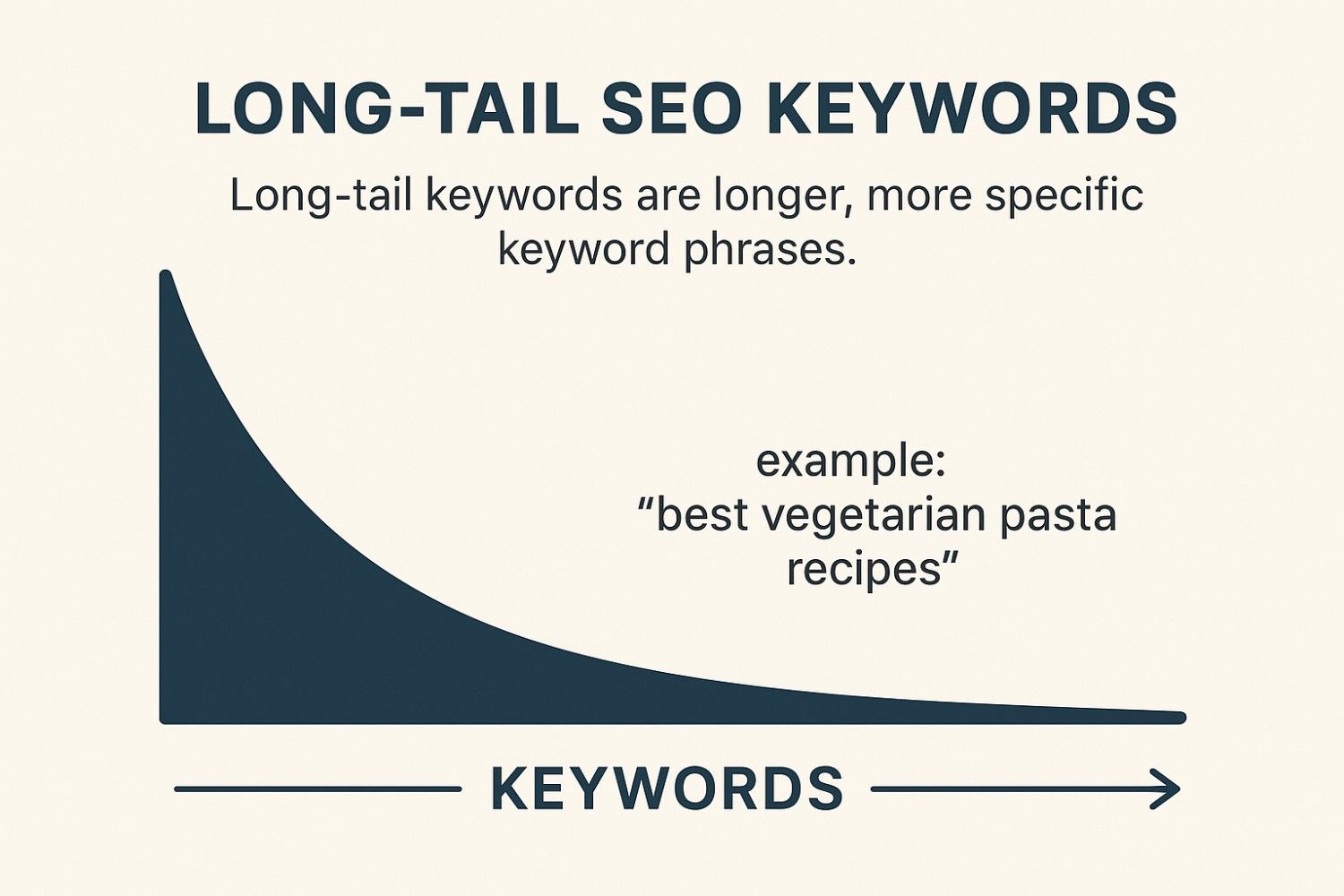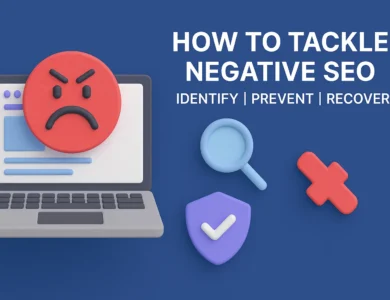
Introduction
If you use search engines, you probably use long-tail keywords without even knowing it.
For example, you might search for warm places to visit in December when planning a holiday or how to make strawberry shortcake on a rainy afternoon.
These are long-tail keywords. They are specific search phrases that help you find exactly what you want.
Because long-tail keywords are specific, they usually have less competition. This makes it easier for websites to rank for them.
In this article, we will explain what long-tail keywords are, why they matter for SEO, and how to find and use them effectively.
What Are Long-Tail SEO Keywords?
Long-tail keywords are longer search phrases that are more specific than broad keywords.

- They are usually used by people who are closer to making a decision or looking for something very precise.
- They have lower search volume but higher intent.
- They are easier to rank for than short generic keywords.
For example, instead of using the broad keyword shoes, you can use best running shoes for flat feet women.
The term “long tail” comes from an analogy of a comet. The comet’s head represents the most popular keywords, while the tail represents the many longer and less common search terms.
Even though a single long-tail keyword may get little traffic, together they make up about 91.8% of Google searches.
- Head keywords like iPad or jobs are very popular but highly competitive.
- Medium-tail keywords are in between for popularity and search volume.
- Long-tail keywords give you a chance to rank higher with less competition.
Why Long-Tail Keywords Are Important for SEO?
Long-tail keywords help you understand what your visitors or customers want.
They Show User Intent
Long-tail keywords can reveal:
What matters in decisions. For example, keywords with best or cheapest like best women’s hoodie.
Popular product features. For example, red hoodie front pocket.
Questions users have. For example, Hoodie Warehouse returns policy.
They Are Specific
Compared to broad keywords, long-tail keywords:
- Have less competition
- Help reach niche markets
- Align with search intent
- Increase chances of conversion
- Reduce cost per click in paid campaigns
For example, if you sell coffee online, using organic coffee beans or best coffee for espresso is easier to rank for than just coffee.
Shoppers searching with long-tail keywords are closer to buying. They know what they want and are more likely to convert.
Optimizing your website or blog for long-tail keywords boosts conversions. You can create content that meets the specific needs of your audience.
This content not only informs visitors but also guides them to related products or services on your site.
For example, from organic coffee beans, you can expand to:
- organic coffee beans benefits
- organic mushroom coffee benefits
- organic coffee benefits for skin
5 Ways to Find Long-Tail Keywords
Long-tail keywords are valuable for marketers.
Below are five ways to discover them:
1. Use Google Autocomplete
Google Autocomplete suggests long-tail keywords as you type.
- Type a generic keyword like coffee machines.
- Google shows variations including long-tail searches.
- These variations reflect real user interest.
For example, coffee machines Makro is specific, has low competition, and is easy to rank for.
Check these keywords with tools like Semrush to see:
- Monthly search volume
- Keyword difficulty
- Search intent
- Trends
2. Use Semrush Tools
Semrush offers multiple tools to discover long-tail keywords:

- Keyword Overview: Check search volume, intent, and competition for up to 100 keywords.
- Keyword Magic Tool: Find keyword ideas related to your target term.
- Keyword Gap: Compare your website with competitors to find opportunities.
For instance, using the Keyword Magic Tool, you can filter results to find keywords with low difficulty and decent monthly searches.
Questions are a great source of long-tail keywords. For example, how to clean a coffee machine with baking soda can inspire detailed content.
3. Analyze Competitors
- Your competitors may already be ranking for valuable long-tail keywords.
- Use Semrush Keyword Gap to compare your site with up to four competitors.
- Find keywords they rank for but you do not.
- Identify gaps in their strategy to target new keywords.
4. Explore Forums and Q&A Websites
Niche forums and Q&A sites show real questions and conversations. These can reveal keywords and content ideas.
- Use Quora, Reddit, GitHub, or Facebook groups.
- Search with site:forum + topic on Google to find relevant discussions.
- Identify common phrasing and questions.
- Use these phrases as long-tail keywords.
5. Use Google Search Console
Google Search Console shows how visitors find your website.

- Check the Performance report for queries.
- Focus on positions 11 to 30. These are second or third-page keywords you can optimize.
- Analyze them with Semrush to see competitiveness and traffic potential.
- Create content targeting these long-tail keywords.
How to Use Long-Tail Keywords in Content?
Long-tail keywords can improve both new and existing content.
For example, instead of repeating paper coffee filter, write naturally about types of paper coffee filters or how to use a paper coffee filter.
Optimize Existing Pages
- Expand pages to cover related long-tail topics naturally.
- Avoid adding irrelevant keywords just to increase density.
Create New Content
- Use long-tail keywords as the focus of new articles or guides.
- Include keywords in page title, URL, subheadings, first and last paragraphs, meta description, and throughout content.
Use Secondary Keywords
- Include related long-tail keywords to strengthen the content.
- Avoid repeating the same keyword unnecessarily.
Common Mistakes to Avoid
Long-tail keywords are powerful but can be misused.
For example, a nonprofit focusing on community outreach may avoid how to double text a cold outreach on LinkedIn. Instead, how to make community outreach video is more relevant.
Ignoring User Intent
Check if your content matches the search intent.
Review SERPs to see what Google shows for the keyword.
Misaligned content may get low engagement and high bounce rates.
Keyword Stuffing
Overusing keywords can hurt rankings and user experience.
Include keywords naturally in content.
Focus on value instead of repetition.
Prioritizing Volume Over Relevance
High search volume does not always mean relevance.
Choose keywords relevant to your audience.
Long-Tail Keywords Are Part of a Bigger SEO Strategy
By using long-tail keywords effectively, you can attract highly targeted traffic, increase conversions, and grow your website or business.
Long-tail keywords are just one part of keyword research.
- Combine them with head and medium-tail keywords for balance.
- Analyze competitors to find new opportunities.
- Use insights from paid search campaigns to strengthen organic SEO.
FAQS
What are long-tail keywords?
Long-tail keywords are long and specific search phrases that people use when they are closer to making a decision or looking for something precise.
How are long-tail keywords different from regular keywords?
Regular keywords are short and broad like shoes. Long-tail keywords are more specific like best running shoes for flat feet women.
Why are long-tail keywords important for SEO?
They help you reach the right audience, have less competition, and increase chances of ranking higher and getting more sales or conversions.
Do long-tail keywords get less traffic?
Yes, each long-tail keyword usually has lower search volume, but together they make up most of the searches on Google.
How can I find long-tail keywords?
You can use Google Autocomplete, Semrush tools, analyze competitors, explore forums and Q&A sites, and check Google Search Console.
Can long-tail keywords improve website conversions?
Yes, because people searching with long-tail keywords usually know what they want and are closer to making a purchase.
Where should I use long-tail keywords in my content?
Use them in the page title, URL, subheadings, first and last paragraphs, meta description, and naturally throughout the content.
What mistakes should I avoid with long-tail keywords?
Avoid ignoring user intent, keyword stuffing, and choosing keywords just for high search volume instead of relevance.
Can I use long-tail keywords for paid search campaigns?
Yes, they usually cost less per click and target specific audiences who are more likely to convert.
Are long-tail keywords enough for SEO?
No, they are one part of a larger strategy. Combine them with other keywords, analyze competitors, and create quality content to rank higher.







